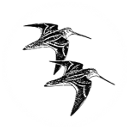Observations
July – August 2020

Throughout July and August, we managed reasonable coverage of the RSPB and HMWT reserves, but we are still not allowed back onto Thames Water land. This meant that about a third of our study area has been unavailable for observations, and of our six major netting sites, four remain inaccessible. Our activities also remain subject to the six persons limit, even for outdoor activities such as birding.
For all the restrictions, it’s debatable how much we’ve missed. From the observations we have been able to make, it is clear this has been a pretty low key autumn for birds, with early departures of local birds and migrants coming through at a trickle.
Wildfowl numbers have been comparatively low. Goose numbers are now boosted each day by roost flights morning and evening up and down the valley, with Canada Geese up to 170, Greylags up to 34, and Egyptian Geese at five.
The autumn build-up of ducks is under way, with maxima to date of 53 Shovelers, 176 Gadwalls, 32 Teal and 9 Pochard. This is of course with wildfowl only being counted in the North Lagoons, the South still being out of bounds. The increase in records of Garganey in recent years continues with one or two birds on seven dates. It is also pleasing to note our breeding Red-crested Pochards seemed to successfully rear their 3 ducklings.
With water levels kept high across the site well into August, as a control measure for Crassula, an invasive non-native plant, wader passage was muted. Pride of place goes to the Wood Sandpiper which appeared on the Scrape and stayed for a week. Also mentioned in despatches is Black-tailed Godwit, which put in an appearance on six dates, with a maximum of six birds. We also recorded Greenshank, Oystercatcher and Little Ringed Plover. They were also joined by a good passage of Common Sandpipers, with a peak of five; up to eight Green Sandpipers were also seen, although as these often feed on the round tanks in the Thames Water Works, we haven’t been able to count them there. Peak numbers on the Scrape and No 1 Lagoon often arise when workers flush them off the Works.
Just to note in passing, our two Barn Owl chicks successfully fledged.
This has been another autumn of slow hirundine passage, and we never had any substantial roosts build up in the Scrape reedbeds. The largest recorded were 50 Swallows and 20 Sand Martins.
There were up to three Whinchats, and ten Yellow Wagtails were recorded going into roost in the meadows at dusk. One or two Grasshopper Warblers lingered through July, and amazingly the only Lesser Whitethroats were a single and a pair in August. There seemed to be influxes of Chiffchaffs on two dates in August, on the second occasion 40 Chiffchaffs were accompanied by five Willow Warblers and two Garden Warblers. Otherwise, warbler numbers were low.
Finally, two Siskins flew over heading west in mid July, an unusually early date, and again in August.
